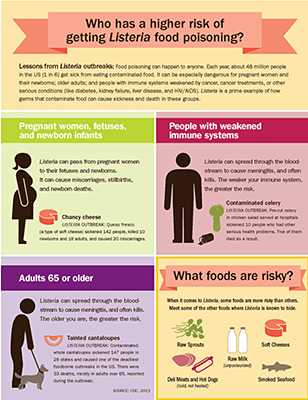Questions and Answers
What is listeriosis?
Listeriosis is a serious infection caused by the germ Listeria monocytogenes. People usually become ill with listeriosis after eating contaminated food. The disease primarily affects pregnant women, newborns, older adults, and people with weakened immune systems. It’s rare for people in other groups to get sick with Listeria infection.
Listeriosis is usually a mild illness for pregnant women, but it causes severe disease in the fetus or newborn baby. Some people with Listeria infections, most commonly adults 65 years and older and people with weakened immune systems, develop severe infections of the bloodstream (causing sepsis) or brain (causing meningitis or encephalitis). Listeria infections can sometimes affect other parts of the body, including bones, joints, and sites in the chest and abdomen.
What are the symptoms of listeriosis?
Listeriosis can cause a variety of symptoms, depending on the person and the part of the body affected. Listeria can cause fever and diarrhea similar to other foodborne germs, but this type of Listeria infection is rarely diagnosed. Symptoms in people with invasive listeriosis, meaning the bacteria has spread beyond the gut, depend on whether the person is pregnant.
- Pregnant women: Pregnant women typically experience only fever and other flu-like symptoms, such as fatigue and muscle aches. However, infections during pregnancy can lead to miscarriage, stillbirth, premature delivery, or life-threatening infection of the newborn.
- People other than pregnant women: Symptoms can include headache, stiff neck, confusion, loss of balance, and convulsions in addition to fever and muscle aches.
People with invasive listeriosis usually report symptoms starting 1 to 4 weeks after eating food contaminated with Listeria; some people have reported symptoms starting as late as 70 days after exposure or as early as the same day of exposure.
How is listeriosis diagnosed and treated?
Listeriosis is usually diagnosed when a bacterial culture (a type of laboratory test) grows Listeria monocytogenes from a body tissue or fluid, such as blood, spinal fluid, or the placenta.
Listeriosis is treated with antibiotics.
How do people get infected with Listeria?
Listeriosis is usually caused by eating food contaminated with Listeria monocytogenes. If infection occurs during pregnancy, Listeria bacteria can spread to the baby through the placenta.
See precautions for people at higher risk of Listeria infection >
What should I do if I ate a food that may have been contaminated with Listeria?
You should seek medical care and tell the doctor about eating possibly contaminated food if you have a fever and other symptoms of possible listeriosis, such as fatigue and muscle aches, within two months after eating possibly contaminated food. This is especially important if you are pregnant, age 65 or older, or have a weakened immune system.
If you ate food possibly contaminated with Listeria and do not feel sick, most experts believe you do not need tests or treatment. Talk with your medical provider if you have questions about what to do after eating possibly contaminated food.
Is listeriosis a serious disease?
Most people with invasive listeriosis require hospital care, and about one in five people with the infection die. When listeriosis occurs during pregnancy, it can cause miscarriage, stillbirth, or newborn death. Listeriosis during pregnancy results in fetal loss in about 20% and newborn death in about 3% of cases.
How many people get listeriosis every year?
Every year, about 1,600 people get listeriosis in the United States.
Are outbreaks of listeriosis common?
A few outbreaks of listeriosis are identified most years. Even though most cases of listeriosis are not part of recognized outbreaks, outbreak investigations help show which foods are sources of listeriosis.
Use the FOOD Tool to see information on foodborne disease outbreaks reported to CDC >
What are public health agencies doing to prevent or control listeriosis?
Federal, state, and local governments are doing the following:
- Providing guidance to industry and developing and enforcing regulations, like the Food Safety Modernization Act, to focus food safety efforts on safer production and handling of foods
- Tracking Listeria infections to identify opportunities to improve policies and practices, particularly to protect groups of people who are more likely to get sick with listeriosis
- Investigating and stopping outbreaks by recalling contaminated foods and warning the public
- Applying CDC’s enhanced approach to investigating Listeria infections in all states so disease detectives can rapidly solve outbreaks by:
- DNA fingerprinting the germ to identify outbreaks and contaminated foods, and interviewing people who are sick – quickly and with the same questions – about what they ate >
- Helping health departments get the technology and training for whole genome sequencing and analysis, which will make it possible to find Listeria infections and outbreaks more quickly, and track them to their sources >
How can I help protect myself and my family from infection?
People who are more likely to get a Listeria infection (pregnant women, people 65 years or older, and people with a weakened immune system and those who prepare food for them can:
- Know which foods are risky and avoid these foods >
- Avoid drinking raw (unpasteurized) milk or eating soft cheeses made from it >
- Be aware that Mexican-style cheeses made from pasteurized milk, such as queso fresco, have caused Listeria infections, likely because they were contaminated during cheese-making > [PDF – 1 page]
- Heat deli meats and hot dogs until steaming hot before eating.
- Refrigerate leftovers within 2 hours in shallow, covered containers and use within 3-4 days.
- Avoid cross-contamination in the refrigerator or other places in the kitchen.
- Use a thermometer to make sure your refrigerator is 40°F or lower and your freezer is 0°F or lower.
Everyone can:
- Page last reviewed: December 12, 2016
- Page last updated: June 29, 2017
- Content source:


 ShareCompartir
ShareCompartir
